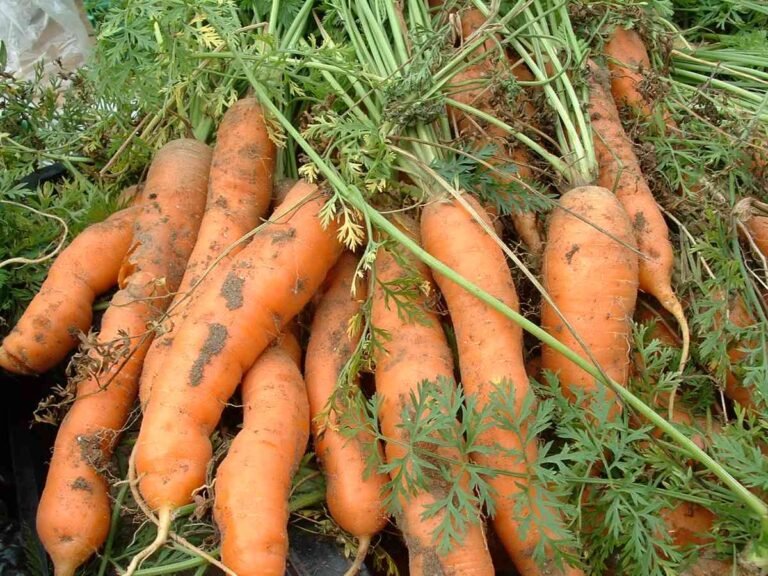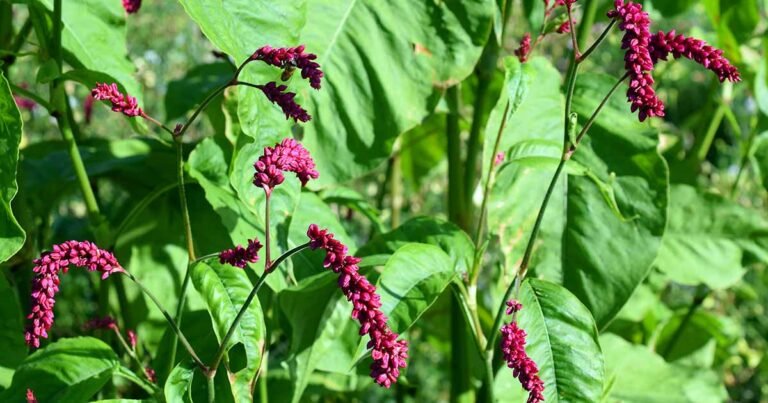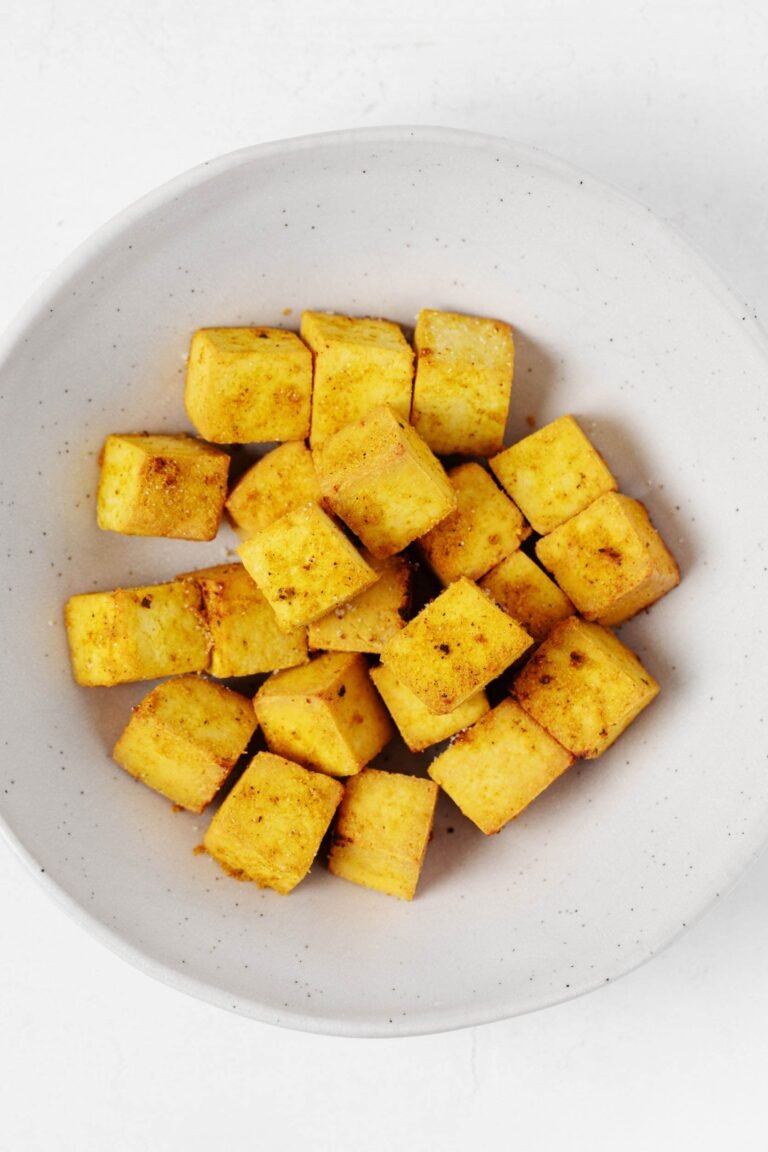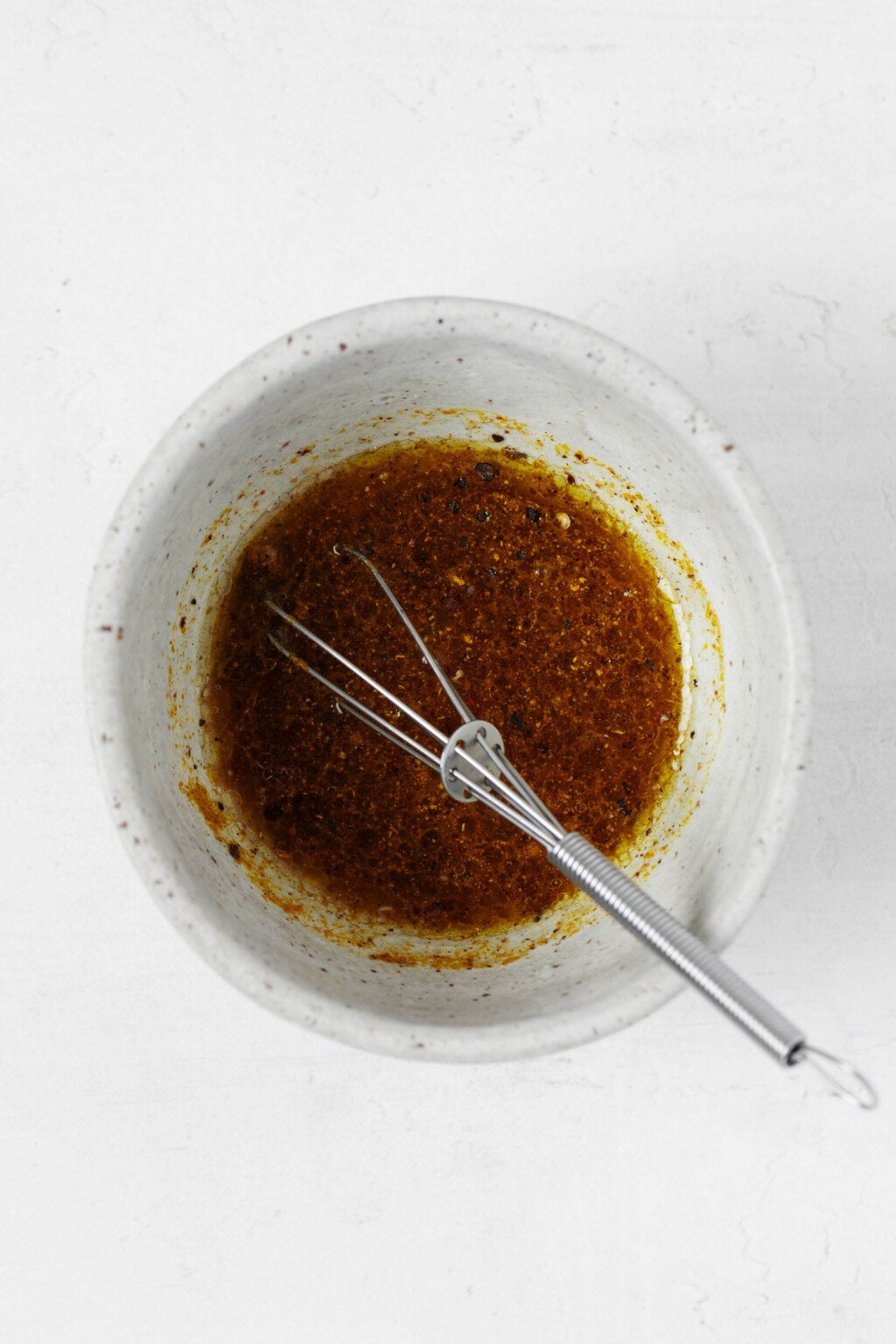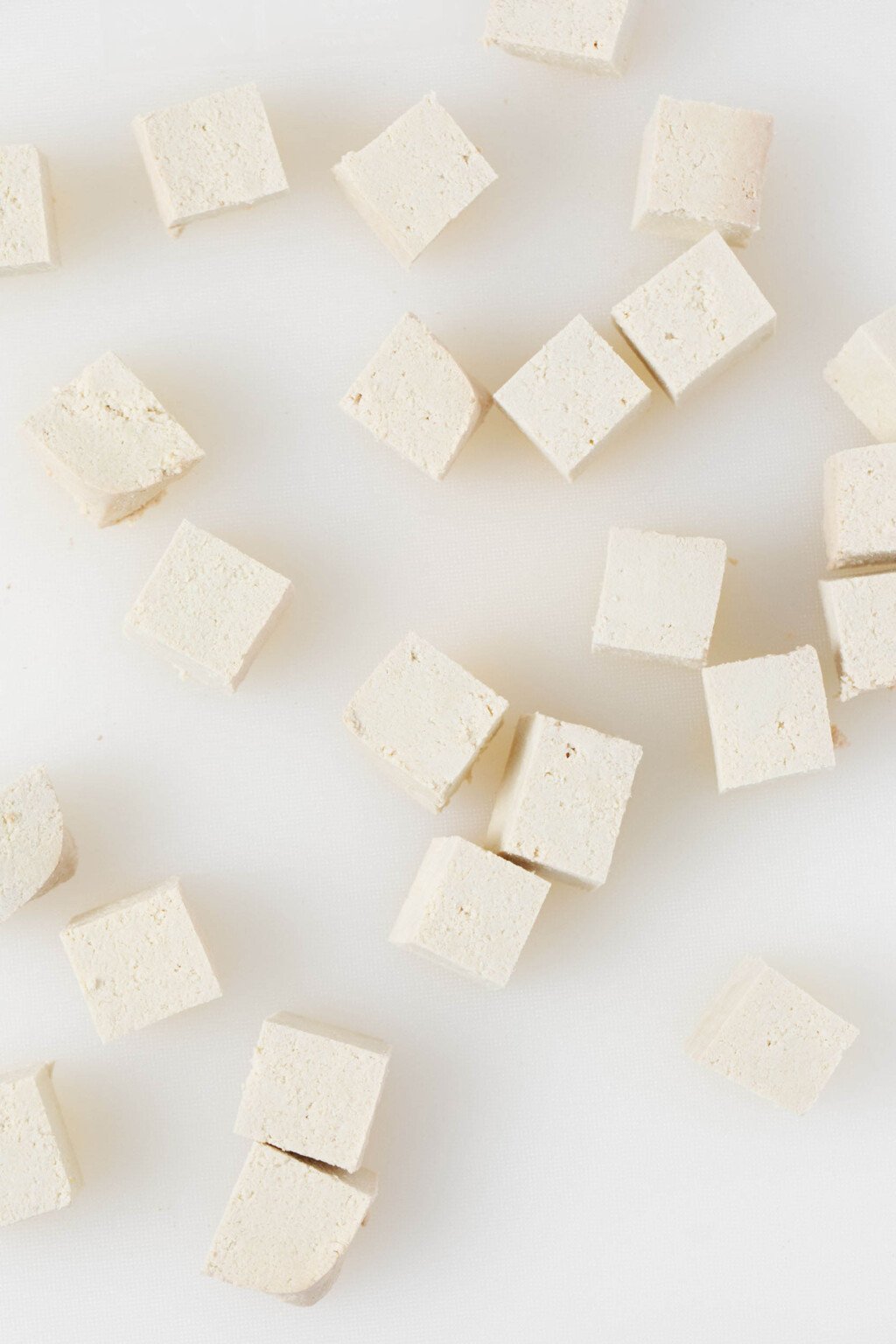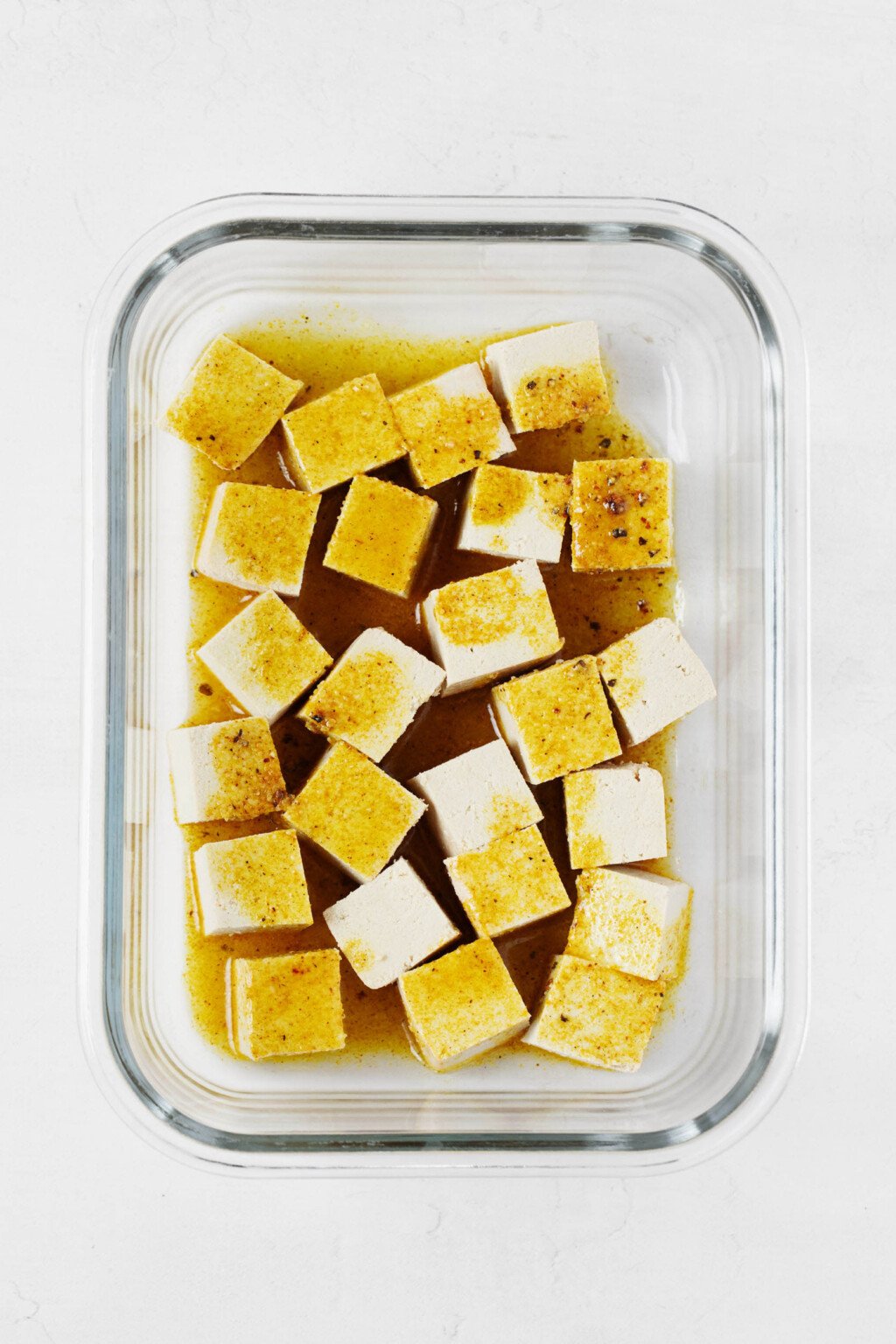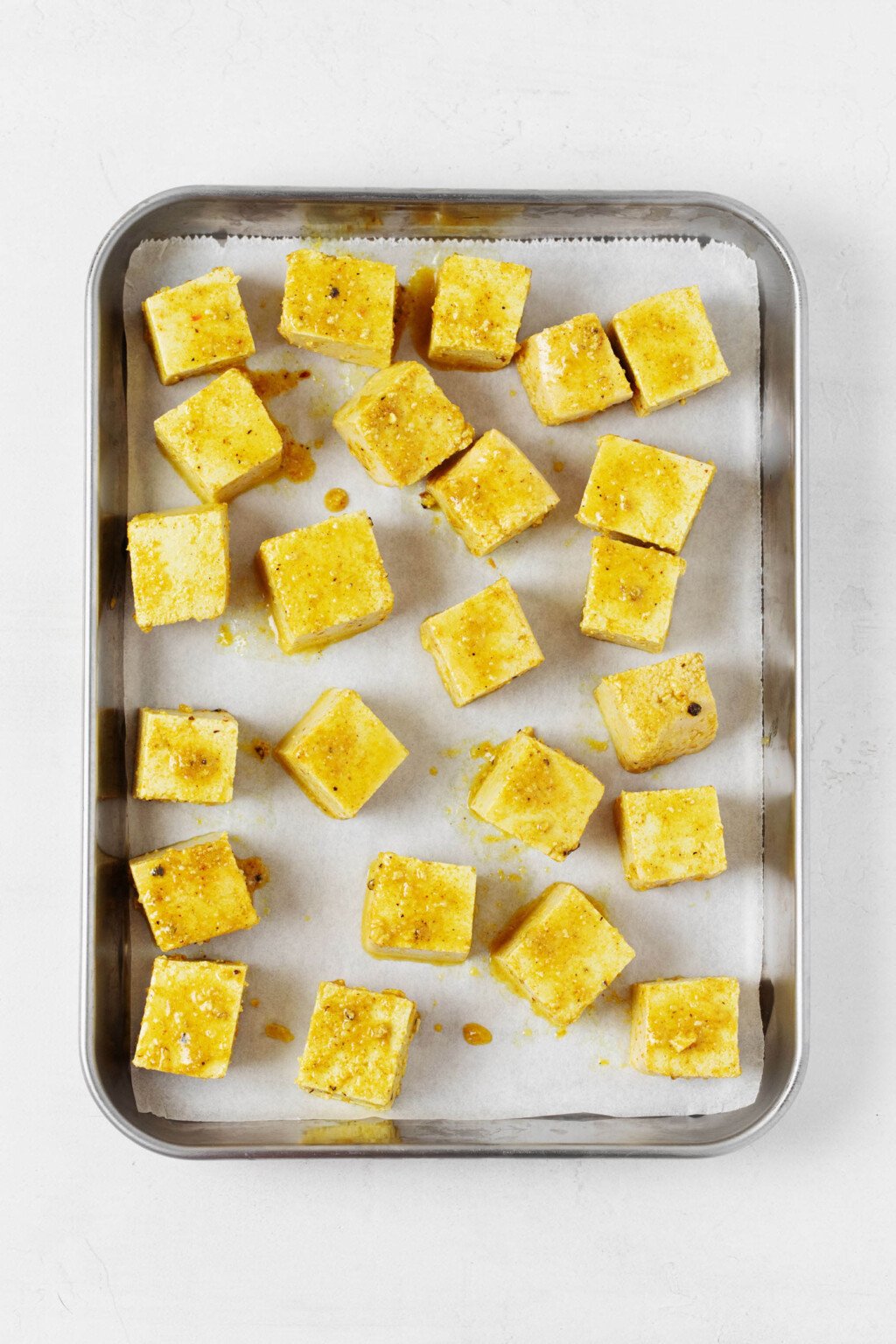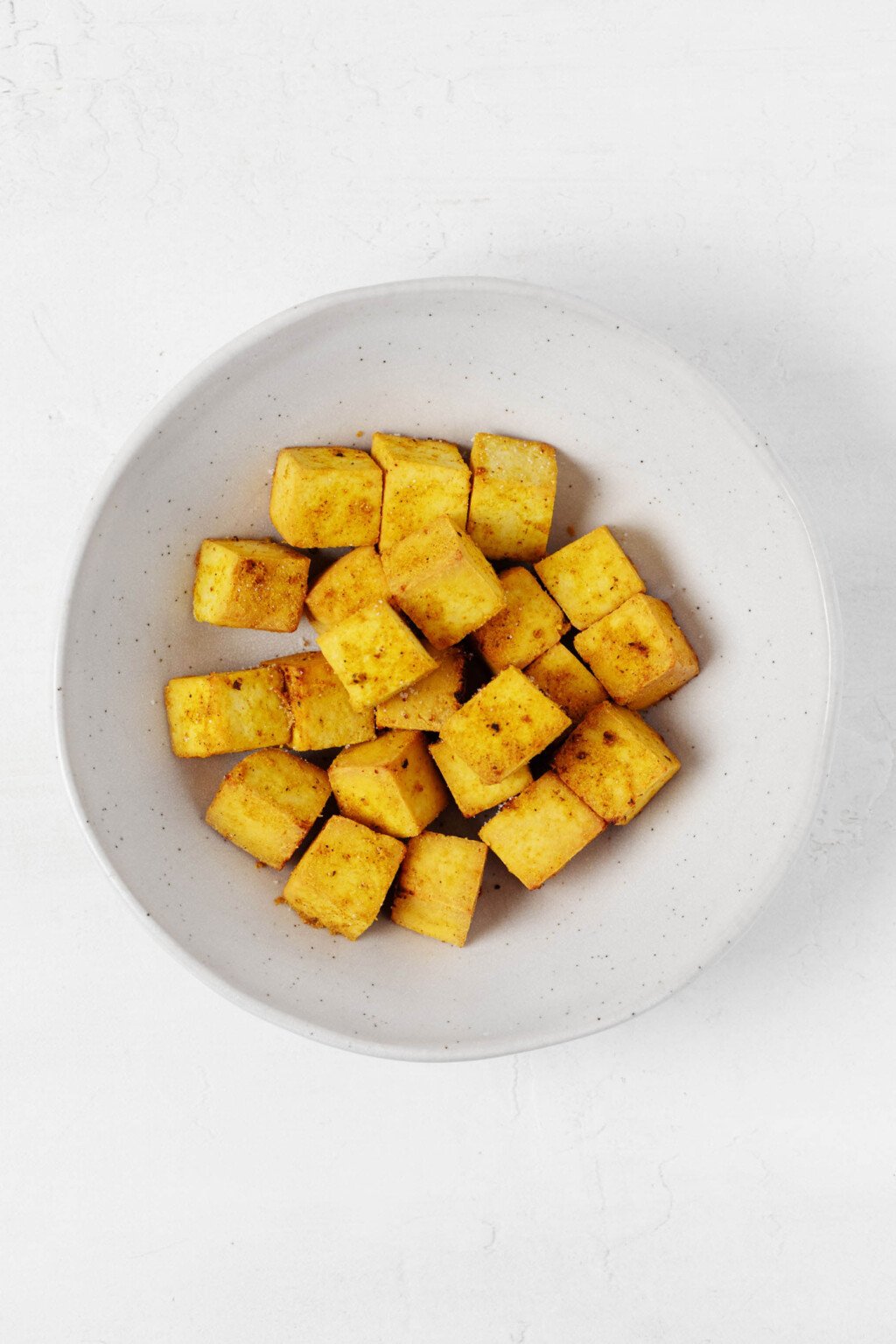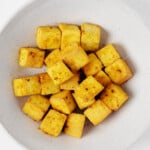1. Alfalfa
Alfalfa (Medicago sativa) isn’t just for horses and donkeys.
Alfalfa sprouts make a tasty and nutritious salad topping, but this member of the legume family can be useful in the garden as well.
When grown with potatoes, it helps reduce populations of Colorado potato beetles.
Keep in mind that alfalfa is a perennial plant, so consider using it between rows of potatoes or around garden beds.
Alfalfa Seeds
You can find organic alfalfa seeds available in your choice of packet sizes from True Leaf Market.
Learn how to grow alfalfa here.
2. Basil
No summer garden would be complete without fragrant basil (Ocimum basilicum) plants, ready to provide heaps of flavor for so many homemade meals.
The strong-smelling leaves aren’t just tasty – they can also repel some common potato pests.
Basil also helps out by attracting beneficial insects with its tiny white flowers if you allow it to bloom.
There are many different varieties of basil, but ‘Lettuce Leaf’ is one of my favorites, with large, crinkled leaves that can be minced into fragrant garnishes.
‘Lettuce Leaf’ Basil
You can purchase one-gram packets of ‘Lettuce Leaf’ basil from Botanical Interests.
Read our guide to growing basil for more info.
3. Borage
Borage (Borago officinalis) is an annual herb with star-shaped blue flowers and soft, fuzzy leaves.
It’s valued both as a companion plant in the garden and for its edible blooms and foliage, which offer a refreshing cucumber flavor.
In the garden, the bright blue flowers draw beneficial insects to protect your potato plants, while the broad leaves create natural ground cover that protects soil and reduces water evaporation.
Borage
Borage seeds are available in a selection of packet sizes at True Leaf Market.
Learn more about growing borage here.
4. Buckwheat
A fast growing annual, buckwheat (Fagopyrum esculentum) is one of the best cover crops for the home garden.
With heart shaped leaves and white-petaled flowers, buckwheat can be grown ahead of your main potato crop, or as a companion plant.
The roots can help to deter wireworms, a common potato pest.
Buckwheat
Pick up buckwheat seeds in an array of pack sizes from High Mowing Organic Seeds.
5. Chives
Chives (Allium schoenoprasum) make an excellent addition to any garden, especially for those who enjoy fresh salads.
These hardy perennials offer a reliable cut-and-come-again harvest, adding earthiness and depth to meals.
The same flavorful compounds that enhance your cooking and liven up your lunchtime salads also benefit the potato patch by repelling pests and providing forage for beneficial insects.
Chives
You can find organic chives seeds in an array of packet sizes at True Leaf Market.
Find out how to grow chives here.
6. Chrysanthemums
You may think of chrysanthemums (Chrysanthemum spp.) as the perfect plants to keep in a container next to your front door for autumn color, but these flowers can be grown as companion plants too.
In fact, researchers in India found that growing potatoes with chrysanthemums was more lucrative than growing them as a monocrop.
Mammoth™ Daisy Coral mums have salmon-colored blooms and they are hardy to Zone 3, so you can grow them as perennials.
Mammoth Daisy Coral Chrysanthemum
You can find Mammoth™ Daisy Coral chrysanthemum plants available at Burpee.
Learn to grow and care for chrysanthemums here.
7. Cilantro
Cilantro (Coriandrum sativum) is a cool-season herb that can be used to garnish potato salads, make guacamole, or create an intense pesto.
And in the garden this member of the carrot family attracts tiny wasps and other beneficial insects to the potato patch with its umbrella-shaped flower heads.
While for culinary reasons you may wish to grow another type of cilantro, when your purpose is to attract beneficial pollinators, one that is fast to bolt, such as ‘Moroccan.’
‘Moroccan’ Cilantro
Buy four-gram packs of ‘Moroccan’ cilantro seeds at Botanical Interests.
Read more about growing cilantro here.
8. Clover
A legume typically grown as a cover crop, clover (Trifolium spp.) works as a companion plant for growing with potatoes as it fixes nitrogen in the soil.
Crimson clover (T. incarnatum) is ideal for this purpose since its red blooms also attract pollinators.
Just keep in mind that this legume is a perennial, and plan your garden accordingly.
Crimson Clover
Pick up crimson clover seeds in a variety of packet sizes at Eden Brothers.
9. Comfrey
Comfrey (Symphytum officinale) is a perennial cousin of borage that is often grown to make a fertilizer tea to nourish the garden.
As a companion plant, grow it with potatoes so that its large, fuzzy leaves can decompose and add nutrients to the soil after you have harvested your crop.
Comfrey
You can find comfrey seeds available at Earthbeat Seeds in packets of 10.
Learn to plant and grow comfrey here.
10. Common Sage
Common sage (Salvia officinalis) is a perennial, aromatic herb with velvety, gray-green leaves and a strong, earthy scent.
This herb helps repel common pests such as flea beetles and cabbage moths from your potatoes while also attracting beneficial predators that support a healthy garden ecosystem.
Common Sage
You can find common sage seeds in packets of 25 from Botanical Interests.
Find tips for growing common sage here.
11. Common Thyme
Herbs tend to make excellent companion plants since their aromatic foliage can repel a number pests while their blooms attract beneficials – and such is the case with thyme (Thymus vulgaris).
An excellent seasoning for soups and stews, common thyme is a perennial culinary herb that is drought-tolerant, and can be grown in a container near your potato crop.
Common Thyme
You can find packets of seeds or live thyme plants available at Burpee.
Read our article for tips about growing common thyme.
12. Corn
One of the members of the traditional three sisters garden, corn (Zea mays) plants provide delicious eating for summer cookouts.
Corn may not be the most obvious companion plant for your root crop, but these lofty garden plants help potatoes in a surprising way.
When these two crops are intercropped, it helps to deter Colorado potato beetles.
‘Fisher’s Earliest’ Sweet Corn
You’ll find organic ‘Fisher’s Earliest’ sweet corn seeds in different packet sizes at High Mowing Organic Seeds.
Learn how to grow sweet corn here.
13. Cosmos
Cosmos (Cosmos spp.) are popular annual flowers that produce loads of colorful blooms atop wispy foliage in exchange for very little care.
And they aren’t just pretty – cosmos are excellent all-purpose companion plants, thanks to their ability to attract beneficial insects helping to keep pest populations around your potato patch under control.
Sensation Mix is a mix of white, lavender, pink, and magenta single flowers, making a colorful addition to the vegetable garden.
Double blooms are also available, but these are less attractive to foraging pollinators.
Sensation Mix Cosmos
You can find Sensation Mix cosmos seeds in a variety of packet sizes from Eden Brothers.
Find tips for planting and growing cosmos here.
14. Dill
Parasitic wasps are a fan of dill (Anethum graveolens), and since they will help keep pests in check, you’ll be a fan too!
Grow this annual herb for its feathery foliage, then let it flower to attract those friendly insects to your potato patch.
When the plants go to seed, you can save the seeds for future crops, or use them to flavor pickles and marinades.
There are many types of dill to choose from – ‘Bouquet’ is an early producer that will provide pollinator food in a hurry.
‘Bouquet’ Dill
You can buy ‘Bouquet’ dill seeds in packs of three grams at Botanical Interests.
Read more about growing dill here.
15. Edamame
Edamame (Glycine max) is a type of soybean that grows in bushy clusters and produces edible pods filled with protein-packed beans.
As nitrogen-fixers, these legumes improve soil fertility by converting atmospheric nitrogen into a usable form, benefiting neighboring plants like potatoes.
‘Midori’ is a type of edamame that produces large beans that are perfect for appetizers and snacks.
‘Midori’ Giant Edamame
You can find ‘Midori’ edamame soybean seeds in a selection of packet sizes from True Leaf Market.
16. Garlic
Related to chives, garlic (Allium sativum) provides depth and flavor to savory meals.
After being planted in the spring for a fall harvest, these bulbs can provide help in the pest deterrent department, reducing the presence of both aphids and leafhoppers around your potatoes.
Do you love garlic but your family, not so much? ‘Inchelium Red’ is a softneck variety with a mild taste that will win over those who aren’t fans of pungent flavors.
‘Inchelium Red’ Garlic
You can purchase half-pound packs of ‘Inchelium Red’ garlic bulbs at Burpee.
Learn how to grow garlic here.
17. Grapevines
Growing potatoes next to a fruiting vine may not have crossed your mind, yet grapevines (Vitis spp.) are a good plant partner for your tubers.
Grapevines are trained on trellises or arbors – and depending on how many you want to grow, you can either grow potatoes at the base of a single vine, or interplant multiple vines with the root crop to make the most of your available space.
Not sure which type of grape to start with? ‘Lakemont’ is a late-season, seedless green table grape that has a honey-like flavor.
‘Lakemont’ Seedless White Grapevine
Purchase bare root or potted ‘Lakemont’ grapevines from Nature Hills Nursery.
Find all the details about growing grapevines here.
18. Green Beans
That staple of the summer garden, green beans (Phaseolus) are produced by both compact, bush-style plants, and on climbing vines.
These annuals make good companion plants for potatoes thanks to their ability to fix atmospheric nitrogen into the soil.
There are many types of edible beans to choose from and they all have this nitrogen fixing quality.
‘Faraday’ is a type of bush bean that bears slender, stringless pods.
‘Faraday’ Green Beans
You can purchase ‘Faraday’ green bean seeds in an assortment of packet sizes from High Mowing Organic Seeds.
Read our guide to growing green beans next!
19. Lima Beans
Lima beans (Phaseolus lunatus) are leguminous plants that produce large beans, also known as butter beans.
As members of the legume family, limas enrich the soil by fixing nitrogen—an essential nutrient that benefits nearby plants like potatoes.
If you grow a pole type of lima, like ‘King of the Garden,’ be sure to plant them to the north of your potatoes, so they don’t throw shade on your spuds.
‘King of the Garden’ Lima Beans
You can find ‘King of the Garden’ lima bean seeds available from True Leaf Market.
Read about growing lima beans here.
20. Marigolds
With bright orange, yellow, or red blooms, marigolds (Tagetes spp.) are popular annual bedding flowers and they make good companions for potatoes too.
And while their cheery blooms attract pollinators and beneficial insects, their roots emit compounds that repel root-knot nematodes, a destructive pest best avoided.
‘Red Metamorph’ is a type of French marigold (Tagetes patula) that is as helpful with its repellent abilities as it is beautiful.
With rare coloring not often found in a marigold, its blooms have burgundy petals and yellow centers.
‘Red Metamorph’ Marigolds
Purchase packets of 36 ‘Red Metamorph’ marigold seeds at Botanical Interests.
Learn how to grow marigolds here.
21. Mint
Perfect for making refreshing iced teas, mint (Mentha spp.) is a vigorous addition to the herb garden.
This fragrant herb also helps to protect potato crops against whiteflies and leafhoppers by acting as a repellent.
Just be mindful when planting that mint can have a tendency to take over the garden, so choose your spot accordingly!
Mint
You can purchase mint seeds in packets of 220 from Botanical Interests.
Get tips on growing mint here.
22. Onions
Related to garlic and chives, onions (Allium cepa) are bulb-forming vegetables grown for their strong aromas and flavors.
These members of the allium family make excellent companion plants for potatoes because their pungent scent helps repel many common potato pests, including aphids.
Bunching onions (A. fistulosum), such as ‘White Lisbon,’ are particularly easy to grow in the garden and have the same beneficial effects as larger types.
‘White Lisbon’ Bunching Onions
You can find packets of 1000 ‘White Lisbon’ bunching onion seeds at Burpee.
Learn more about growing onions here.
23. Oregano
Oregano (Origanum vulgare) is a flavorful herb popular on pizzas that also makes a good companion for potatoes.
The foliage has such a strong smell that it helps to keep some pests away, while the flowers attract beneficial insects.
This Mediterranean herb is also easy to start from seed, making it an affordable addition to the herb garden.
Oregano
Pick up a packet of 800 common oregano seeds from Botanical Interests.
Get tips for growing oregano here.
24. Peas
Peas (Pisum sativum) are cool-season legumes that produce sweet, edible pods and seeds.
As nitrogen-fixers, peas enrich the soil by converting atmospheric nitrogen to a bioavailable form, boosting the nutrient availability for neighboring crops like potatoes.
‘Sugar Daddy’ is a type of snap pea that produces delicious, sweet, and crisp pods that are also stringless.
‘Sugar Daddy’ Snap Peas
You can find ‘Sugar Daddy’ snap peas in 50-gram packets at Botanical Interests.
Learn how to grow peas here.
25. Rosemary
Rosemary (Salvia rosmarinus) is a fragrant, woody herb with needle-like leaves and a strong, fresh aroma.
The invigorating scent helps deter pests like Colorado potato beetles and other harmful insects while the delicate blooms attract pollinators.
Rosemary
Find packets of 32 rosemary seeds from Botanical Interests.
Read more about growing rosemary here.
26. Scented Geraniums
Scented geraniums (Pelargonium) are vibrant, flowering plants with brightly colored blooms and highly fragrant foliage.
Commonly enjoyed in window boxes, scented geraniums can also be grown with your potato crop as companion plants.
‘Citronella’ Scented Geraniums
Purchase a two-, four-, or six-pack of ‘Citronella’ scented geranium plants in four-inch nursery pots from Soil Sunrise via Walmart.
Find out more about growing scented geraniums here.
27. Spinach
A fast-growing leafy green, spinach (Spinacia oleracea) has a shallow root system that doesn’t compete with the tubers.
And since it matures quickly, spinach is harvested early, giving potatoes more space as they grow, making the most of garden space, and promoting a healthy growing environment.
‘Bloomsdale’ spinach is an heirloom that produces nutrient-rich, tender leaves.
‘Bloomsdale’ Spinach
You can find eight-gram packets of ‘Bloomsdale’ spinach at Botanical Interests.
Learn more about growing spinach here.
28. Sunflowers
You love sunflowers (Helianthus annuus) for their big, cheery blooms and nutritious seeds, but did you know they can also serve as companion plants for potatoes?
Researchers in China concluded that both water use and yield was more efficient when sunflowers and potatoes were interplanted.
With so many different types of sunflowers, it can be hard to choose just one.
‘Velvet Queen’ has yellow and burgundy petals, reaches five feet tall, and happens to be one of the best sunflowers for pollinators.
‘Velvet Queen’ Sunflower
Grab packets of ‘Velvet Queen’ sunflower seeds in a wide range of sizes from High Mowing Organic Seeds.
Read about growing sunflowers here.
29. Sweet Alyssum
Are you looking for a low-growing ground cover that will also attract beneficial insects? Sweet alyssum (Lobularia maritima) is your gal.
With tiny flowers in shades of white, purple, or pink, sweet alyssum will act as a living mulch while feeding helpful bugs, and making your garden look gorgeous at the same time.
Allure Pastel Blend bears a mix of purple, white, and pink flowers, for gardeners who can’t decide which color to grow.
Allure Pastel Blend Sweet Alyssum
You can find packets of Allure Pastel Blend sweet alyssum seeds from Botanical Interests.
Get tips for growing sweet alyssum here.
30. Tansy
With delicate, fern-like foliage and button-shaped yellow flowers, tansy (Tanacetum vulgare) may not be very common, but this herb does have its devotees.
Tansy is not used as a culinary herb as much as a medicinal one, and should be used in moderation as it contains a potentially toxic compound.
In the garden, tansy repels Colorado potato beetles making it ideal for growing near your potatoes.
Tansy
You can find tansy seeds in an assortment of packet sizes from True Leaf Market.
31. Zinnias
For some gardeners, zinnias (Zinnia spp.) are as much of a standby in the vegetable patch as in the flower border.
That’s because these annual flowers are good general companion plants, attracting beneficial insects like ladybugs and hoverflies to your potato crops.
California Giants is a favorite zinnia blend that produces large, four- to six-inch flowers in shades of pink, red, orange, purple, white, and yellow.
California Giants Blend Zinnias
You’ll find two-gram packets of California Giants Blend zinnias at Botanical Interests.
Get tips for growing zinnias here.
And Some to Avoid
While potatoes, bell peppers, eggplant, and tomatoes all belong to the nightshade family and share similar growing needs, they aren’t ideal neighbors in the garden.
These plants are prone to many of the same pests and diseases.





